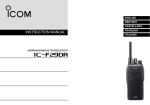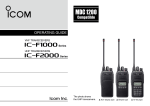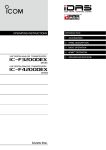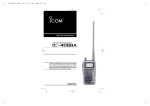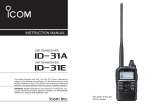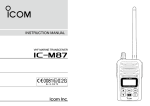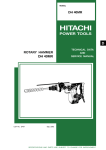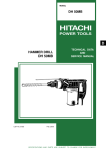Download ICOM IC-F29SR two-way radio
Transcript
BASIC OPERATION DDTurning ON the power Sends the preselected ring tone of your group members. •Call your group members with a Call-Ring qqSet the same operating channel and CTCSS tone for all of your group transceivers. wwHold down [Upper] for 1 second to send the preselected ringer to your group members. ➥➥ Rotate [VOL] to turn ON the power. DDReceiving and Transmitting •Receiving qqRotate [ROTARY SELECTOR] to select a channel. wwWhen receiving a call, rotate [VOL] to adjust the audio output to a comfortable listening level. DDSmart-Ring operation This function has an answer back feature. You can confirm whether or not a call has reached your group members, even if the operators are temporarily away from their transceivers. The called transceiver automatically sends an answer back call to your transceiver. NOTE: To insure the readability of your signal: 1. A fter pushing [PTT], pause briefly before you start speaking. 2. Hold the microphone 5 to 10 cm from your mouth, and then speak at your normal voice level. qqSet the same operating channel and CTCSS tone for all of your group transceivers, as described on the reverse side of this sheet. wwPush [Upper] to make the Smart-Ring call. • When an answer back is received, the transceiver sounds beep tones every 10 seconds and the LED indicator blinks orange. - Push [Lower] to stop the beeps and the LED blinking. • When no answer back is received, the transceiver sounds short failure beeps. eePush [PTT] to answer the call and stop the beeps and blinking. NOTE: This function is usable only when the called stations’ transceivers are set to the same CTCSS tone and operating channel. OPTIONS DDBATTERY PACKS BP-278 7.2 V BP-279 1130 mAh (minimum) 1190 mAh (typical) 1485 mAh (minimum) 1570 mAh (typical) Thank you for choosing the IC-F29SR pmr446 transceiver. READ ALL INSTRUCTIONS carefully and completely before using the transceiver. Iç-F29SR SUPPLIED ACCESSORIES Battery pack (BP-279) RECOMMENDATION CLEAN THE TRANSCEIVER THOROUGHLY WITH FRESH WATER after exposure to saltwater, and dry it before operating. Otherwise, the transceiver's keys, switches and controllers may become unusable due to salt crystallization. Battery charger (BC-213) NOTE: DO NOT submerge the transceiver in water if you suspect the waterproof protection may not be effective, especially after one of the following: Belt clip (MB-133) Power adapter* (for the battery charger) •The transceiver has been dropped •The transceiver’s case or the waterproof seal is cracked or damaged •The jack cover or the optional HM168LWP is detached from the transceiver. * Not supplied, or the shape is different, depending on the transceiver version. For accessory attachment details, download the IC-F29SR operating guide from the Icom web site. (http://www.icom.co.jp/world/support/) PANEL DESCRIPTION [VOL] Rotate to turn the power ON or OFF, and to adjust the audio level. Antenna DDOTHERS •BP-278/BP-279 battery pack Capacity PMR446 TRANSCEIVER • The ringer sounds while holding down [Upper]. • The same ringer sounds from your group members’ speaker. •Transmitting Wait until the channel is clear to avoid interference. qqWhile holding down [PTT], speak at your normal voice level. wwRelease [PTT] to receive. Battery pack Voltage INSTRUCTIONS DDCall-Ring operation Before using the transceiver for the first time, the battery must be fully charged for optimum life and operation. •MB-130 mobile bracket •MB-133 belt clip Battery life* •HM-158LA, HM-159LA, HM-168LWP speaker microphone 16 hours 21 hours •HM-153LA, HM-166LA earphone microphone HS-94, HS-95, HS-97 headset + VS-4LA ptt switch cable HS-94: Ear-hook type HS-95: Neck-arm type HS-97: Throat microphone VS-4LA:To connect headset and for PTT use *W hen the power save function is turned ON, and the operating periods are calculated under the following conditions: TX:RX:standby = 5:5:90 DDCHARGERS •BC-213 desktop charger + BC-123S ac adapter •BC-214 multi charger + BC-157S ac adapter Some options may not be available in some countries. Ask your dealer for details. DDDC CABLES Approved Icom optional equipment is designed for optimal performance when used with an Icom transceiver. Icom is not responsible for the destruction or damage to an Icom transceiver in the event the Icom transceiver is used with equipment that is not manufactured or approved by Icom. •CP-23L cigarette lighter cable For BC-213. •OPC-656 dc power cable For BC-214. LED INDICATOR • Lights red while transmitting. • Lights green while receiving a signal, or when the squelch is open. • You should charge the battery when the indicator slowly blinks green. • You must charge the battery when the indicator quickly blinks green. [PTT] Hold down to transmit, and release to receive. Microphone [Upper]*/[Lower]* [Upper]:Push to make a Smart-Ring call. Hold down to make a Call-Ring call. [Lower]:Hold down to cancel the CTCSS (DTCS) mute. SPEAKER-MICROPHONE JACK Connect an optional speaker microphone. Speaker *Other functions can be assigned to these keys with the CS-F29SR cloning software (purchase separately). Icom, Icom Inc. and the Icom logo are registered trademarks of Icom Incorporated (Japan) in Japan, the United States, the United Kingdom, Germany, France, Spain, Russia and/or other countries. All other products or brands are registered trademarks or trademarks of their respective holders. –1– For more information, download the IC-F29SR operating guide from the Icom web site. (http://www.icom.co.jp/world/support/) –4– [TOP]* No function is initially assigned. [ROTARY SELECTOR] Rotate to select the memory channels. 1-1-32 Kamiminami, Hirano-ku, Osaka 547-0003, Japan A-7150H-1EU Printed in Japan © 2014 Icom Inc. EXPLICIT DEFINITIONS WORD DEFINITION RDANGER! Personal death, serious injury or an explosion may occur. RWARNING! Personal injury, fire hazard or electric shock may occur. CAUTION NOTE Equipment damage may occur. If disregarded, inconvenience only. No risk of personal injury, fire or electric shock. PRECAUTIONS • Radio caution R DANGER! NEVER short the charging terminals of the battery pack. Even when the radio power is OFF, a slight current still flows in the circuits. Remove the battery pack from the radio when not using it for a long time. Otherwise, the installed battery pack will become exhausted, and will need to be recharged or replaced. R DANGER! Use and charge only specified Icom battery packs with Icom radios or Icom chargers. Only Icom battery packs are tested and approved for use with Icom radios or to be charged by Icom chargers. Using third-party or counterfeit battery packs or chargers may cause smoke, fire, or cause the battery packs to burst. MAKE SURE to turn OFF the radio power before connecting the supplied or optional equipment. • Battery caution Misuse of Li-ion batteries may result in the following hazards: smoke, fire, or the battery pack may rupture. Misuse can also cause damage to the battery pack or degradation of battery performance. R WARNING! NEVER hold the radio so that the antenna is very close to, or touching exposed parts of the body, especially the face or eyes, while transmitting. The radio will perform best if the microphone is 5 to 10 cm away from the lips and the radio is vertical. R DANGER! NEVER short terminals (or charging terminals) of the battery pack. Also, current may flow into nearby metal objects such as a key, so be careful when placing the battery packs (or the radio) in handbags, etc. Simply carrying with or placing near metal objects such as a key, etc. may cause shorting. This may damage not only the battery pack, but also the radio. R WARNING! NEVER operate the radio with a headset or other audio accessories at high volume levels. The continuous high volume operation may cause a ringing in your ears. If you experience the ringing, reduce the volume level or discontinue use. R WARNING! NEVER operate the radio while driving a vehicle. Safe driving requires your full attention—anything less may result in an accident. R DANGER! DO NOT hammer or otherwise impact the battery pack. Do not use the battery pack if it has been severely impacted or dropped, or if it has been subjected to heavy pressure. The damage may not be visible on the outside of the case. Even if the surface of the battery pack does not show cracks or any other damage, the cells inside may rupture or catch fire. CAUTION: MAKE SURE the flexible antenna, battery pack and jack cover are securely attached to the radio, and that the antenna and battery pack are dry before attachment. Exposing the inside of the radio to dust or water will result in serious damage to the radio. R DANGER! NEVER use or leave the battery pack in areas with temperatures above +60°C. High temperature buildup in the battery pack, such as could occur near fires or stoves, inside a sun heated car, or in direct sunlight for long periods of time may cause the battery pack to rupture or catch fire. Excessive temperatures may also degrade performance or shorten battery life. DO NOT operate the radio near unshielded electrical blasting caps or in an explosive atmosphere. DO NOT push [PTT] when you do not actually intend to transmit. DO NOT operate or place the radio in direct sunlight or in places with temperatures below –30°C or above +60°C. The basic operations of the radio are guaranteed within the specified operating temperature range. R DANGER! DO NOT expose the battery pack to rain, snow, seawater, or any other liquids. Do not charge or use a wet battery pack. If the battery pack gets wet, be sure to wipe it dry before using. DO NOT modify the radio. The specifications may change and then not comply with the requirements of a corresponded regulation. The radio warranty does not cover any problems caused by unauthorized modification. R DANGER! KEEP the battery pack away from fire. Fire or heat may cause them to rupture or explode. Dispose of an used battery pack in accordance with local regulations. DO NOT use harsh solvents such as benzine or alcohol when cleaning, as they will damage the radio surfaces. BE CAREFUL! The radio may become hot when operating it continuously for long periods of time. BE CAREFUL! The radio meets IP67* requirements for dusttight and waterproof protection. However, once the radio has been dropped, dust-tight and waterproof protection cannot be guaranteed because of possible damage to the radio’s case or the waterproof seal. PRECAUTIONS (continued) BE SURE to replace the battery pack with a new one after five years, even if still holds a charge. The inside battery material will deteriorate after a period of time, even with little use. R WARNING! Immediately wash, using clean water, any part of the body that comes into contact with fluid from inside the battery pack. R WARNING! NEVER put the battery pack in a microwave oven, high-pressure container, or in an induction heating cooker. This could cause a fire, overheating, or cause the battery pack to rupture. • Charging caution R DANGER! NEVER charge the battery pack in areas with extremely high temperatures, such as near fires or stoves, inside a sun-heated vehicle, or in direct sunlight. In such environments, the safety/protection circuit in the battery pack will activate, causing the battery to stop charging. CAUTION: Always use the battery pack within the specified temperature range, for the radio (–30°C to +60°C) and the battery pack itself (–20°C to +60°C). Using the battery pack out of its specified temperature range will reduce the performance and the life. Please note that the specified temperature range of the battery pack may exceed that of the radio. In such cases, the radio may not work properly because it is out of its operating temperature range. R WARNING! NEVER charge or leave the battery pack in the battery charger beyond the specified time for charging. If the battery pack is not completely charged by the specified time, stop charging and remove the battery pack from the battery charger. Continuing to charge the battery pack beyond the specified time limit may cause a fire, overheating, or the battery pack may rupture. CAUTION: Shorter battery life could occur if the battery pack is left fully charged, completely discharged, or in an excessive temperature environment (above +50°C) for an extended period of time. If the battery pack must be left unused for a long time, it must be detached from the radio after discharging. You may use the battery pack until the remaining capacity is about half, then keep it safely in a cool and dry place at the following temperature range: –20°C to +50°C (within a month) –20°C to +40°C (within three months) –20°C to +20°C (within a year) R WARNING! NEVER insert the radio (the battery pack attached to the radio) into the charger if it is wet or soiled. This could corrode the battery charger terminals or damage the charger. The charger is not waterproof. NOTE: Charge the battery pack within the specified temperature range of +10°C to +40°C. Otherwise, the charging time will be longer, but the battery pack will not reach a full charge. While charging, at a point after the temperature goes out of the specified range, the charging will automatically stop. BATTERY CHARGING DDRapid charging with the supplied BC-213 Power adapter (A different type, or no power adapter is supplied, depending on the transceiver version.) The BC-213 desktop charger rapidly charges the Li-ion battery pack. The BC-213 is used with the power adapter or the CP-23L cigarette lighter cable (purchase separately). Turn OFF the Power CAUTION: STOP charging if the charge indicator lights orange and green alternately. This indicates charging failure is occurring. CP-23L (for 12 V cigarette lighter socket) can be used instead of the power adapter. NOTE: Charge the battery within the specified temperature range of +10°C to +40°C. Otherwise, the charging time will be longer, but the battery will not reach a full charge. While charging, at a point where the temperature goes out of the specified range, the charging will automatically stop. DDRapid charging with the BC-214 R DANGER! NEVER solder the battery pack terminals, or modify the battery pack. This may generate heat in the battery, and the battery pack may burst, emit smoke or catch fire. The BC-214 multi charger* can simultaneously charge up to 6 Li-ion battery packs. The BC-214 is used with the BC-157S ac adapter or the OPC-656 dc power cable (Purchase separately). R DANGER! Use the battery pack only with the radio for which it is specified. Never use a battery pack with any other equipment, or for any purpose that is not specified in this sheet. •Charging time of the BP-279 Approximately 2 to 3 hours Charge indicator • Lights orange while charging. • Lights green when charging is completed. BC-213 Transceiver + Battery pack Battery pack only BC-214 R WARNING! Immediately stop using the battery pack if it emits an abnormal odor, heats up, or is discolored or deformed. If any of these conditions occur, contact your Icom dealer or distributor. –2– Transceiver + Battery pack •Charging time of the BP-279 Approximately 2 to 3 hours R DANGER! If fluid from inside the battery pack gets in your eyes, blindness can result. Rinse your eyes with clean water, without rubbing them, and see a doctor immediately. *Only when the jack cover or the optional HM-168LWP is attached. Battery pack only Turn OFF the power OPC-656 Connect to a DC power supply: 12 to 16 V, at least 7 A Red line: + Black line: _ BC-157S –3–



